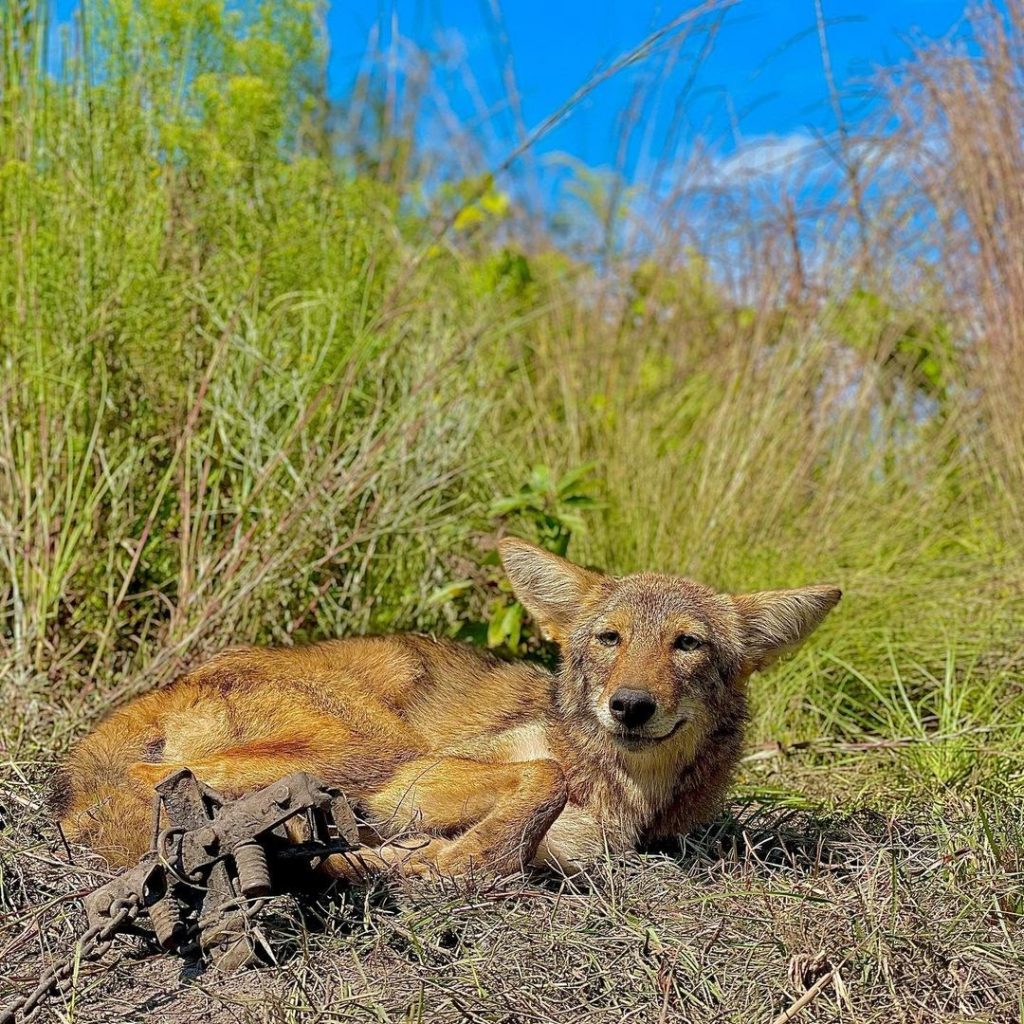Bullmastiff vs Coyote: Can Your Dog Protect You?
Large, powerful, and intimidating. The Bullmastiff can make any trespasser scamper off his line of territory. But, what if he ends up facing a Coyote? This wild animal is common in the United States and although it rarely attacks humans, it still poses a threat most times due to the 367 cases it’s been involved in from 1977 to 2015.


At its best state, a Bullmastiff can most likely protect you from a Coyote. However, several factors can affect the outcome such as if the foe outnumbers your home protector or if your pet is old and sickly. Find out more fascinating details regarding this encounter below…
Table of Contents
How To Spot a Coyote


The Coyote closely resembles the wolf. However, he’s much smaller than the red and eastern wolves. His coat is typically grayish-brown and appears thick and long in most areas of his body. In his underparts, you would find his whitish fur which contributes to his overall defense against extreme cold or climates.
His ears stand tall and erect as if he’s always alert for whatever opportunity crosses his path. Just like the wolves, he has a long muzzle. His nose is black, he mostly sports a yellow pair of eyes, and his tail appears thick and bushy.
A more convenient way to tell the difference between a coyote, a dog, and a wolf is by their tails. While a dog runs with its tail up high and the wolf sprints straight out, the Coyote darts with his tail down.
How Big Is a Bullmastiff Compared to a Coyote?


The Bullmastiff wins the size contests if put up against a Coyote. He stands tall at 24 to 27 inches and weighs heavily from 100 to 130 pounds with males being generally larger in proportions than their female counterparts.
On the other hand, the Coyote averagely reaches heights of about 24 inches and can have a mass between 20 to 50 pounds. Additionally, the ones who are of the Northern Subspecies of Mexico tend to grow larger than those from the south.
With the size difference. It is just natural for many of us to assume right away that the Bullmastiff has all the advantages. However, the Coyote begs to differ. This wily animal can, no doubt, win a fight against the canine if some factors come into play.
Who Has the Edge in a Fight?
The animal who is in better shape and has more fighting experience or an adequate amount of training can secure victory. The outcome will change if one opponent has several others behind him and the other has to brawl alone. Let’s see each possible scenario to help us have a better image of the fight and to be able to arrive at a more sound conclusion.
Young Bullmastiff vs Adult Coyote
Unsurprisingly, a young Bullmastiff won’t stand a chance against an adult Coyote. Puppies in particular, highly need protection from their mothers or owners. They are still considered helpless and inexperienced dogs. Cases have reported that when a puppy encounters a Coyote, it can end up being eaten or infected by rabies after a minor skirmish.
Adult Bullmastiff vs Young Coyote
Although it is rare for a Bullmastiff to end up facing a Coyote pup, still, such an event could be possible. If ever this does happen, a Bullmastiff who has high levels of predatory instinct would end up harming the pup. He also has the instinct to chase after small animals, and the young Coyote being minute, might not last a day unless somebody intervenes at the scene.
One Bullmastiff vs A Pack of Coyotes
Most probably, a grown Bullmastiff can handle a few Coyotes. However, if the ratio is higher, your dog’s chance to win decreases. Anyhow, if this happens, he won’t turn his back without giving them a fight. Intelligence and amount of training will help him outwit these wild animals. Although rationally, a Bullmastiff can’t kill the pack, chances are that the fight will end up in a draw.
A Pack of Bullmastiff vs One Coyote
Taking into consideration the size difference between the Bullmastiff breed and the Coyote, surely, the wild beast won’t get the victory. How much more if there are 3 or more Bullmastiffs ready to pounce at him? The best way for him to live another day is to scamper off and avoid the confrontation as early as possible.
Comparing Abilities
To learn more about our two beautiful subjects, we would have a better perspective regarding their skills and abilities by determining which between them is better at a given aspect. Let’s find out!
Who’s Faster?
Coyotes run an average of 34 to 43 miles per hour making him beat the Bullmastiff’s record which is only 15 to 20 miles per hour. The former can keep sprinting on longer distances compared to the canine as well. From this area, hands down, the Coyote wins it.
Who’s More Clever?
Coyotes are smart and versatile creatures. Their exposure in the wild as well as in unique situations has honed them for the better. The fact that humans try to tone down their numbers even made them grow larger in population. This manifests how adaptive they are. Meanwhile, the Bullmastiff is also an intelligent breed. However, he’d need someone to train him so he’d be suitable as a domesticated pet.
Comparing both vastly different animals in terms of intellect would depend on which aspect do we base this contest upon since the other thrives best in the wild while the other does better at a home with a family. Therefore, we can conclude that both dogs are smart in their rights.
Who Can Jump Higher?
Although not really a jumper, the Bullmastiff can jump over a 1.5-meters tall fence while an average Coyote can leap a height of 1.8 meters. While Coyotes rely on their ability to run in circles or escape the fight, the Bullmastiff relies more on his strength and power.
Who Has a Stronger Bite Force?
The English Mastiff and the fierce Bulldog comprise the Bullmastiff’s bloodline. The Mastiff has about 552 PSI while the Bulldog also boasts its 305 impressive bite force. From these numbers, we can tell that the Bullmastiff’s level would be anywhere near those figures.
On the other hand, a Coyote only has at least 153 PSI. The medal in this aspect is won by the Bullmastiff breed.
Who is More Territorial?
Transient Coyotes have low territorial instincts since they visit several places in a short period. However, those who have a territory to defend are very protective, especially when other Coyotes who do not belong from the pack are spotted from a distance or have pups to safeguard.
Trained Bullmastiffs are also territorial for the right reasons. They want their homes respected and not trespassed, and they take their duties seriously to guarantee family safety; however, if no abnormal behaviors are exhibited by someone, they will observe rather than show aggression right away.
Protect Your Bullmastiff From Potential Coyote Attacks
Gradually, some Coyotes start leaving their wild habitat due to scarcity of food resources. They start venturing to somebody’s neighborhood in search of chickens, lambs, cats, and even your pet dog. Here are some ways to protect your Bullmastiff from Coyote attacks:
- Never leave your Bullmastiff outside unsupervised.
- Invest in a 7-feet tall fence topped with barbed wire and is buried deep to the ground.
- Install outdoor lights that can shoo Coyotes away. Get it here on Amazon!
- Get rid of the dog’s poop and fruits that fell from the tree. Close your garbage cans as well.
- Make a loud noise to startle off a Coyote. You can use a quality whistle or horn.
Frequently Asked Questions
Can Coyotes Mate With Bullmastiffs?
Yes, Coyotes are strongly attracted to dogs such as the Bullmastiff, most especially if the canine is unspayed or unneutered. When an unspayed Bullmastiff is in heat, this will lure several male Coyotes nearby while unneutered ones will be tempted to go after the scent of an ovulating female Coyote.
What we usually call the canine hybrid is “Coydog” and unfortunately, most states in the US deem breeding of such kind as illegal.
Can a Dog and a Coyote Get Along With Each Other?
Yes, it is possible! If he shows a confident certain style of manners that is not threatening to a well-socialized Bullmastiff, he might just be able to play with the canine or even grow a sort of a unique bond uncommon for us.
However, this happens very rarely and most encounters could end up in a serious fight. As much as you can, avoid getting a Coyote and a dog, especially when either of their body languages exhibits discomfort, to interact with each other as the former is a genuine threat and a predator.
